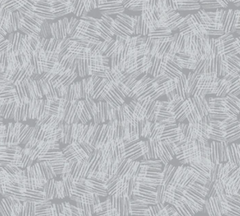One of the workshops I attended at QuiltCon Together was Maritza Soto's Color Interplay. While watching Maritza choose colours for her project, I realized the importance of value (the lightness or darkness of a colour) in many of my designs. There are often various and distinct design elements in my quilts; some have been included as secondary or tertiary elements (meaning they weren't put there to be the star of the show!). Instead they may have been included to add depth, movement, or asymmetry. When colour values are used correctly, these crucial supporting actors help to tell a much more effective story.
This post will provide you with the tools to select colour values intentionally in order to communicate the design effectively.
What do I mean by this exactly? Let's have a look at The Last Kiss quilt pattern to demonstrate how strategically placed colour values help to compliment the design.
My Fabric Pull
I've chosen FIGO Fabrics' Serenity collection for
The Last Kiss sew along beginning March 1, 2021 and will use them to demonstrate the concept. These four fabrics will become the 4-colour lap version and two pillow covers. Each will introduce a different value to be considered in the layout.
The Brief
When I designed this pattern, the contrasting kiss motifs were the main design elements, and the stripes/dot elements were subtle additions for interest and asymmetry. To summarize, here's the brief to help us decide on the best colour value placement:
- high contrast in the kiss motifs
- low contrast between the the stripes/dot and background
Let's have a look at the examples below to determine which ones best achieve the brief.
The Examples
On the left is the colour mockup, in the middle is that mockup in greyscale, and on the right is an improved version.
The greatest contrast in the original mockup is between the dark background and the light stripes/dot. When the mockup is converted to grayscale, the two medium values in the kiss motif appear too similar even though they are entirely different colours. These choices don't fit the design brief, so let's change things around.
To improve the placement of values, you may choose to exchange the stripes/dot light value with one of the medium values in the kiss motifs as seen in the far right image. The contrast between the background and stripes/dot is reduced, while the kiss motif halves present greater contrast.
Let's look at another example:
This example illustrates a similar scenario. The kiss motifs have the least contrast when grayscale is applied, and the stripes make the greatest visual impact. In the far right illustration, a better balance is achieved by using the two medium values in the background, and the two high-contrast values in the kiss motifs.
Once you've established where your values are best suited to convey the message of your design, you can experiment by alternating colours/fabrics within the same value. For example, I can invert the two medium values and still achieve my brief:
You don't need your fabric choices in-hand to determine whether they'll have your desired effect. Here are a couple of options:
- Take a photograph of your sketch, illustration, or fabric bundle. Select the "grayscale" filter on your phone's camera to help make your value selections.
- If you are using Illustrator: Choose Edit > Edit Colors > Convert To Grayscale.
I hope this eliminates any uncertainty around choosing fabrics for graphic designs where contrast can make or break the message. Remember to decide what elements will play the main and supporting roles in your design, and choose values that communicate those choices.
Join me for a casual sew along of The Last Kiss Quilt during March 2021. It's a great opportunity to put this concept to the test. The pattern is on sale until February 28, 2021.












